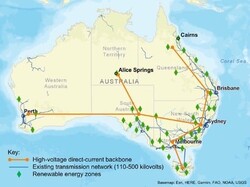Eastern Climate Action Melbourne
We have the technology... what we need is the money to build it
We know the energy transition is on - the power system of the future will need to be two to five times larger than what we have now when we electrify homes, transport, buildings and industry. That is a huge investment opportunity
A clean energy grid powered by renewable energy would look like this
We know the energy transition is on - the power system of the future will need to be two to five times larger than what we have now when we electrify homes, transport, buildings and industry. That is a huge investment opportunity
A clean energy grid powered by renewable energy would look like this

The cost of the transition from the dirty grid we have now to the clean grid of the future is approximately $300 billion. Money that can be invested for this work can come from Superannuation funds, government, and private sources. Currently there is approximately $3 trillion dollars in Australian Superannuation - if 10% was invested in projects to transition to a clean grid, it would be enough to fund all the work.
Investment in the power grid is low risk because the production is predictable, and the consumption of power can be sold in long term contracts. The coal generation we have now is getting old and will need to be replaced.
Currently Superannuation funds are not allowed to invest in the clean energy transition to the extent that is needed. This is
Investment in the power grid is low risk because the production is predictable, and the consumption of power can be sold in long term contracts. The coal generation we have now is getting old and will need to be replaced.
Currently Superannuation funds are not allowed to invest in the clean energy transition to the extent that is needed. This is
because the federal government has classified investment in renewables as a risk.
Addressing the risks and changing the investment rules would allow superannuation money to be invested, resulting in:
Addressing the risks and changing the investment rules would allow superannuation money to be invested, resulting in:
- More employment/jobs than in the coal/gas industry (that is much smaller than your think)
- More jobs/economic activity in the regions, as that is where this infrastructure will be
- Cheaper, reliable power - as the sun and wind are plentiful and free
- Improve energy security - stop importing 98% of our transport fuels
- Reduce emissions
- Better health due to lower toxic emissions
- New manufacturing - if we get ahead and make use of the raw resources Australia has, instead of being ranked 93 on economic complexity
- Refining minerals in Australia to increase export value, instead of shipping soil and energy overseas for someone else to do it (more jobs)
- Reduced risks to farming and infrastructure and homes from extreme weather (bushfire, flood, damaging winds)
- Improved water security (Coal power stations use vast quantities of drinking water)
